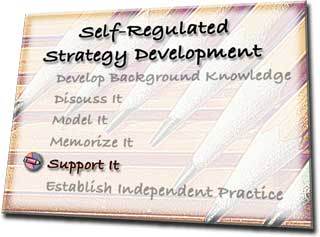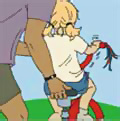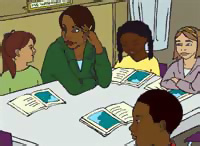What procedures might Ms. Lin suggest?
Page 8: Support It
Mr. Carter recognizes that, although his students now know the purpose of the writing strategy and have memorized all of its steps, they are not yet ready to use the strategy independently. It’s now time for Mr. Carter to integrate the next critical instructional stage—support the students. In order to support his students in becoming independent writers, Mr. Carter will:
 Collaboratively use the writing and self-regulation strategies with his students
Collaboratively use the writing and self-regulation strategies with his students- Use strategy charts and graphic organizers
- Make sure they work toward attaining their initial writing goals
- Increase his students’ goals gradually until their final goals have been reached
- Offer constructive feedback guidance and positive reinforcement
- “Fade” (or modulate) his support based on their individual needs
- Discuss with his students ways to maintain, or continue to use, the strategy
- Support his students so that they are able to use the strategy in other settings

To better understand this concept, consider the analogy of learning to ride a bike. For example, a girl might know the parts of the bike and how the bike works, but she still needs some help before she is ready to ride on her own. Her dad might start by holding her as she slowly pedals, but then he gradually lessens his support so that his child can acquire a feel for balancing and pedaling. Next, the dad will run along beside the bike as she rides, just so she knows that he’ll be there to catch her. And then, at last, his daughter is ready to ride on her own. This process can be described as scaffolding, and it works the same for riding a bike as it does for strategy instruction.
scaffolding
Instructional technique in which teachers offer support for students learning new skills by systematically and explicitly building on their experiences and knowledge.
Keep in Mind
The teacher may need to provide extended student support for students who are struggling before they are ready to practice the strategy on their own.
Mr. Carter encourages his students to take ownership of the writing strategy by providing opportunities for his students to practice the first steps of the strategy independently before adding new steps. Most of his students are able to independently use the strategy after two to four practice sessions. But, as needed, he provides them with opportunities to practice the writing strategy through a variety of instructional groupings (Click here for examples). Because Mr. Carter takes the time to allow his students to master each step, they are more likely to maintain the strategy as well as to generalize it to other situations.
Examples of Instructional Groupings
The table illustrates different types of instructional grouping in which teachers can support their students.
One-on-one Instruction

- Support is provided via the teacher working with an individual student.
- The teacher targets the specific difficulties faced by the student.
- Modeling is geared toward a student’s needs.
Small Group Instruction

- Support is provided via the teacher during small group instruction.
- The teacher provides small group instruction for students who are still struggling to learn to use the strategy.
- The teacher provides additional assistance and practice in the small group.
Peer Pairing

- Support is provided via peers working together.
- Peers assist and remind one another of the procedures to be implemented during their application of the strategy.
- Teachers assist as needed.
(Close this panel)
Mr. Carter also supports his students by reminding them to use their self-regulation strategies. Self-reinforcement generally involves students using reinforcing statements to bolster their own performances, rather than relying on other types of reinforcements (e.g., points, tokens).
Listen to Karen Harris talk about self-reinforcement (time: 0:20).
Karen Harris, PhD
Division of Educational Leadership and Innovation
Arizona State University, Tempe, Arizona

Transcript: Karen Harris, PhD
It’s quite common to use self-instructions for self-reinforcement, so you can use self-statements. In that case, they’re not really self-instructions anymore. They’re statements, so quite a lot of the self-reinforcement that children and adults give themselves is verbal. With young children, it will quite often be out loud: “I got it. I did it. I like this. I’m doing good,” that kind of thing.
Click on the movie below to see a teacher support the class through guided practice before using the WWW, What=2, How=2 strategy independently. Notice that the teacher uses self-talk and self-monitoring during her demonstration. She models these two types of self-regulation strategies based on the needs of her students (time: 2:26).
Transcript: Support the Students
Teacher: So who’s my main character going to be on my family trip?
Student: Fast guy driving.
Class: (Laughter)
Teacher: I’m going to put “guy driving.” So do you notice I don’t write complete sentences? These are just my thoughts, ’cause when I write and say more, that’s going to be everything. So these are just so I can keep my thoughts down on paper. I kind of call this sometimes, like, caveman talk. “Guy driving.” Okay? It’s not sentences. When we write notes, it’s not sentences. So I have my “Who?” What am I going to put next? Kathleen?
Kathleen: “When.”
Teacher: “When.” So when did my story happen?
Kathleen: In the 1950s.
Teacher: 1950s, all right. Whoo. What am I going to write next? Where does the story take place? Where does it take place? Kara?
Kara: In America.
Teacher: In America, all right. So how am I doing so far? What can I say to myself? Am I doing a good job?
Class: Yes.
Teacher: I’m doing a good job. I’m getting all my parts. My story’s gonna make sense. So what am I going to add now?
Student: First “What.”
Teacher: First “What.” So what happens? Or what does the main character do or want to do?
Student: They want to go to Niagara Falls.
Teacher: “Go Niagara Falls.”
Teacher: So I’m going to read our story. I want your listening ears on. If you hear the first part or second part or third part, remember to raise your hand, okay? “One day in 1950…” Sarah?
Sarah: 1950.
Teacher: 1950. What part is that?
Sarah: “When.”
Teacher: “When.” All right, so you guys can color one box.
Student: Can we color the second…
Teacher: No, you can color the first box. So: “One day in 1950, a guy is driving with his family in a car…”
Student: Uh, “Who.”
Teacher: Which is “Who?”
Student: A guy.
Teacher: A guy. Is there another “Who?” Will?
Will: His family.
Teacher: His family. But you just color one box for the “Who,” okay?